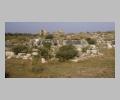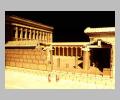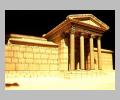| Context: | Miletus |
| Type: | Bouleuterion |
| Summary: | Council house consisting of a rectangular hall with semi-circular rows of seats, a peristyle courtyard in front, and a propylon; located in the city center between the north agora and the south agora. |
| Date: | ca. 175 BC - ca. 164 BC |
| Dimensions: | Dimensions of entire complex 34.84 m. x 55.90 m.; dimensions of bouleuterion 34.84 m. x 24.28 m.; width of flights of steps between seats 0.70 m.; height of engaged exterior columns ca. 5.15 m.; lower diameter of engaged columns 0.75 m.; upper diameter ca. 0.60 m. Dimensions of courtyard 34.84 m. x 31.62 m.; width of colonnade in courtyard 5.53 m. Width of propylon 10.89 m.; intercolumniation of propylon 2.74 m.; lower diameter of columns of propylon 0.75 m.; projection of propylon beyond exterior wall of courtyard 5.60 m.; column height (incl. base and capital) of propylon 6.97 m. |
| Region: | Ionia |
| Period: | Hellenistic |
Architectural Order:
Doric, Ionic and Corinthian. The columns of the colonnaded courtyard in front of the bouleuterion are of the Doric order. The exterior walls of the bouleuterion, in their upper half, were decorated with engaged Doric half-columns, with pilasters at the corners and corresponding pilasters on the interior walls of the bouleuterion. The Doric capitals of this exterior order were elaborated with the addition of an ovolo molding at the echinus. Four Ionic columns inside the council hall helped support the roof. The capitals of the propylon at the east end of the court were of elaborate Corinthian design.
Plan:
The complex consists of three main elements: a propylon at the east facade, a rectangular courtyard with interior colonnade around its north, east and south sides, and the bouleuterion or council hall located at the west (rear) of the complex. The propylon had four prostyle Corinthian columns in front of antae; an additional two Corinthian columns, corresponding to the central two of the facade, stood in the Doric colonnade of the courtyard. The bouleuterion itself is a rectangular hall, oriented roughly north-south. It was entered via four doors from the courtyard to the east, and through two doorways in the west wall. Within the hall are eighteen rows of stone seats, slightly greater than a semi-circle. Four radiating flights of steps provide access to the seats from the orchestra area; additional stairs lead to the upper seats from the rear corners of the building. The seating capacity was ca. 1200-1500. Two pairs of Ionic columns on pedestals originally helped support the roof; later, wooden posts were added.
Date Description:
The primary evidence for the date of the complex comes from the dedication inscription carved on the architrave of the east wall of the bouleuterion; an identical text also appeared on the exterior architrave of the propylon.
History:
The building complex is securely dated to the years 175 - 164 B.C., through the evidence of two dedication inscriptions preserved on the architrave of the bouleuterion itself and the architrave of the propylon. The inscription records that two brothers, Timarchos and Herakleides, dedicated the building, on behalf of Antiochus IV Epiphanes, to Apollo of Didyma, Hestia Bulaia and the demos of Miletus. Restorations and renovations to the bouleuterion include the following: an additional door added in the east wall; the restoration of the rows of seats and the extension of the rows to a horseshoe formation; and the erection of a structure in the center of the courtyard. These restorations probably date to the Augustan period. In the late empire, a mosaic floor was laid parallel to the east wall of the bouleuterion, and the courtyard was paved with marble slabs. In the center of the Doric courtyard is a monumental structure, most recently and convincingly interpreted as an altar, not a funerary monument
Other Notes:
The text of the inscription from the architrave of the propylon (more complete than that from the bouleuterion) is restored as follows:
Other Bibliography:





